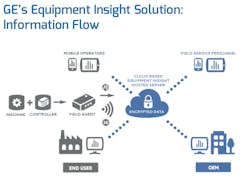Large equipment manufacturers know that their machines are extremely valuable—not only to the OEM, but to their customers. Downtime or outages associated with the equipment that OEMs produce are extremely expensive in terms of lost production for the OEM. Not to mention the potential for damaged rep- utations and negative impacts to the bottom line for both the OEM and its customer.
Having spent a great deal of time visiting OEMs that are remotely monitoring their distributed fleets or in the process of trying to do so, I’ve had some lengthy conversations with several C-level OEM managers about how they’re approaching the remote monitoring process. In a nutshell, it seems like the process of collecting, analyzing and making decisions from equipment data has been a pretty painful process for most OEMs—more painful than it needs to be.
Following are key points of insight I’ve heard repeatedly from OEMs about why they’re interested in remote monitoring and diagnostics:
- They’re looking for new ways to improve the performance of their installed assets;
- They want to improve their end customers’ experience;
- They’re seeking to create new revenue-generating service models; and
- They’d like to reduce their overall cost-to-serve.
For these executives, a few of the major pain points to implementing remote monitoring and diagnostics include:
- Virtually centralizing unlike applications, devices and sensors via a web-based remote monitoring and diagnostic solution is often harder than anticipated.
- Developing an elegant user interface that is customizable for end-user accounts and optimized for both browser and mobile environments is tough.
- Few people have clarity on what a three-tiered data privacy model between an automation vendor, OEM and end user should look like.
- Collecting and historizing large amounts of data, making sense of that data, and reporting it in actionable ways requires expertise and time...lots of time. Acquiring and keeping that expertise in-house is also costly.
- Developing and maintaining homegrown remote monitoring and diagnostics software that delivers on customers’ expectations also requires expertise and lots of time. It is also expensive. Furthermore, abandoning and writing off the sunk costs of homegrown systems affects people’s pride and, in some cases, people’s livelihood. All in all, it’s not an easy decision to make.
These recent conversations left me wondering: Why do OEMs bother with trying to deliver homegrown remote monitoring and diagnostics solutions themselves? OEMs are, by nature, engineering organizations, not software and IT domain experts. And yet these companies frequently acquire and retain an HMI engineer, a software engineer (or two or three), and an IT team to figure out how to make software applications work on top of their machines, when instead they could go the “appliance” route and save themselves tons of time at work.
The type of appliance I’m referring to here is a pre-engineered and pre-built solution for a specific problem that significantly reduces the engineering costs and risks for customers. To provide an idea of how such an appliance works, consider GE Intelligent Platforms’ new Equipment Insight solution. This appliance, powered by GE’s Proficy software and RXi industrial PCs, enables OEMs to securely collect data from connected machines, analyze that data, and get actionable information to people to deliver better service levels and optimize equipment performance, leading to new revenue streams and improved customer satisfaction.
Alarms, overall equipment effectiveness (OEE) and key performance indicator (KPI) data can be viewed in a single, accessible screen on an OEM’s mobile device using Equipment Insight. Plus, a customized risk index provides advanced analytics and predictive detection, allowing OEMs to contact customers before their process goes down.
When it comes to keeping tabs on an OEM’s machinery once it’s deployed in the field, the appliance route to remote monitoring and diagnostics can effectively reduce costs—in terms of money, resources and time—by leveraging a small number of experts to monitor and troubleshoot an entire fleet of assets.
Learn more about Equipment Insight at the GE Intelligent Platforms site.
About the Author
Melanie Brittingham
Solution Marketing, Equipment Insight, GE Intelligent Platforms

Leaders relevant to this article:
